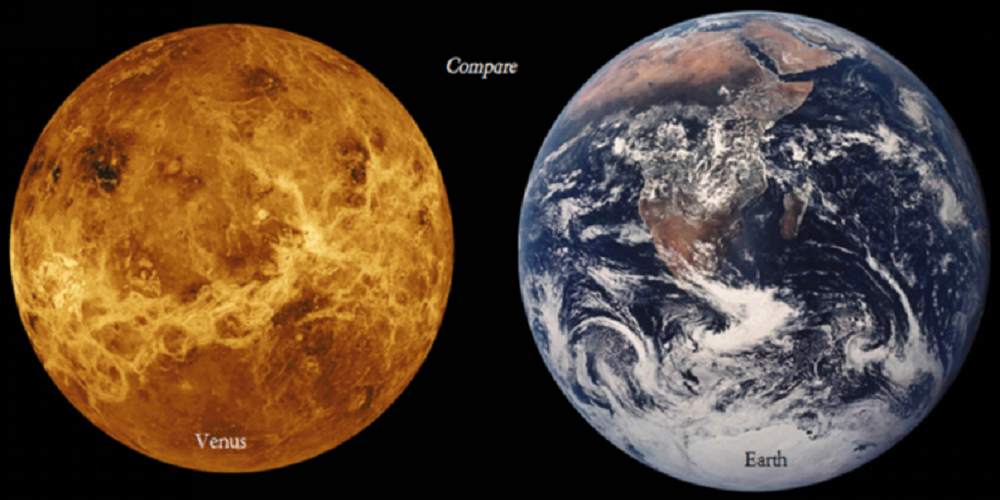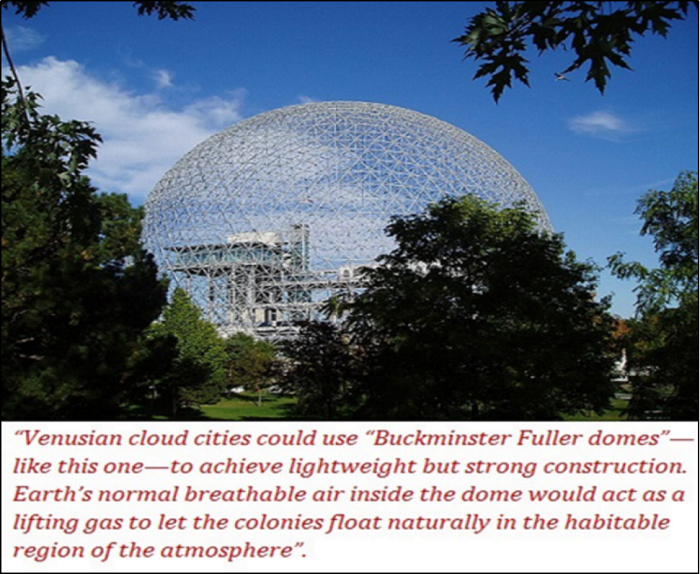Venus, Earth’s Sister

Venus is, by most standards, a hellish world . . . Yet that thick, heavy, toxic atmosphere is exactly what makes Venus an appealing world for humans to eventually live on. But then you do have to think “outside the box”— in that, no rule says that to live on another planet means actually living on that planet’s surface! It’s quite possible, you see, to use Venus’ thick atmosphere to our advantage, and build floating “Cloud Cities”.
There are so many similarities between Earth and Venus that numerous scientists consider the two to be nearly twin planets; fact is, its though happenstance, the two planets evolved in different directions. It is believed that both planets share a common origin, forming at the same time, about 4.5 billion years ago. In fact, Venus is often referred to as our sister planet because of similarities in size, mass, density, age, and volume.
Then too, there are a few interesting irregularities worth mentioning between Venus and Earth. Such as the direction of Venus’s rotation - the Sun rises in the west and sets in the east; the “spin cycle” of the planet is so slow that a “day” on Venus is equal to 243 Earth days & nights, while the Venusian year is just under 225 (224.7) Earth days & nights.
Our current knowledge of the planet Venus’ surface and its interior is similar to the knowledge we held of Mars in the 1970’s following NASA’s Viking I & II missions. The Soviet Union placed a total of 8 probes on the surface of Venus, beginning with Venera 7 in 1970 and ending with Venera 14 in 1982; each of which took simple measurements within the 110 minutes or less before the surface environment’s heat “cooked” each probe’s on-board electronics. Our last, best source of information stems from NASA’s Magellan spacecraft which mapped the surface of Venus while in orbit. Needless to say, the radar equipment used was developed in the early 1990’s (not so great by today’s standards), regardless, as was planned, Magellan crashed and burned onto the planet’s surface.
You see, mapping Venus’ surface requires using imaging radar that can penetrate its thick cloud cover. Unfortunately, as suggested above, the technology in the early 1990’s when Magellan flew was comparatively new and crude, if compared to today’s engineering. Alternatively, modern (2024) imaging radars are often used to study the surface of the earth — both from airplanes and from satellites. The good news, such technology is well established and is now relatively low cost.
During the past few years, something of a cottage industry has grown-up proposing new missions to map Venus. Dissimilar accounting rules make exact cost estimates difficult, but the proposed missions by most estimates would cost in the neighborhood of $600 Million at most. Well yea, that’s a lot of money, but, then NASA’s approved budget for 2024, was a whopping $24.875 Billion, which, by the way, is a 2% cut from 2023.
So why spend all those US Taxpayer Dollars on a place in our Solar System that seems extremely unlikely to ever be suitable for supporting an Earth colony? If for no other reason, we should look at each of our neighboring planets to help understand the perils of global warming. Case-in-point, it is generally believed that both Venus and Mars started out much like Earth and then changed, thus holding priceless information for Earth’s climatologists.
Even though Venus’s atmosphere is much thicker than Earth’s, current climate models can reproduce its present temperature structure without a problem. Planetary scientists could therefore turn the clock back so as to understand why and how Venus changed from former Earth-like conditions into the “hellhole” it is today.
In Short, the greenhouse effect on Venus is often cited as a terrifying example of what may well happen to Earth if we don’t get our current pollution patterns under control.
With a carbon dioxide rich atmosphere, a pressure that’s nearly 92 times what we feel on Earth, and an average surface temperature that’s nearly 900° Fahrenheit, to say, “Venus does not have a welcoming environment”, is an understatement. Venus is a planet of extremes. Yes, a few physical characteristics are similar, but there are more differences than not. The most critical of which are perhaps the average surface temperatures: Earth—14° Celsius / 57° Fahrenheit . . . Venus—462° Celsius / 864° Fahrenheit.
Nevertheless, roughly 31 miles above the planet’s surface, Venus is still almost “Earth-like.” Beyond most of the clouds there’s enough sunshine to provide solar power, the temperature is warm yet cool enough for liquid water to exist, and the gravity is about 90% of what we experience here on Earth. The gases at that altitude can also support life, all though a little help is necessary, and there’s enough carbon dioxide to facilitate plant growth. The nitrogen in the air along with hydrogen gathered from floating sulfuric acid droplets can be converted into the elements necessary to support human life.

The argument for a colonizing program on Venus was suggested by Geoffrey Landis, a scientist at NASA’s Glenn Research Center in a presentation back in 2003. More than a decade later, it’s still a captivating idea.
Needless to say though, a “Floating City” on Venus is not a novel idea, as is depicted in the image displayed above left; this idea actually dates back to the Russians in the early 1970’s — Yep, appears the “Soviet’s”, back in the day, had something beyond “Cities” in mind.
Truly the surface of Venus is far too hot, and the surface atmosphere much too dense for life derived from Earth to survive — yet it’s worth repeating that 31 miles above the surface of Venus lies, shall we say, “The Goldilocks Zone”, which exists within the planet’s atmosphere. Now keep in mind that on Venus, Earth type air is actually a “lifting gas” with about half the “lifting power” helium has on Earth. Therefore, much like Weather Balloons rise to their operating level in Earth’s atmosphere, this method of operation should work in the same way for floating “cities” on Venus.

Earth bound Weather Balloons float at a level where the pressure is equal inside and out and can be built of light construction materials as is the case with a “Buckminster Fuller dome” (see image above), for example which could “house” small cities or farms. So, 31 miles beyond the Venusian surface is arguably the most hospitable region for humanity anywhere within our solar system, outside of Earth itself.
Simply put, a habitat filled with normal breathable “Earth air” could float high above the hostile surface of Venus where the atmospheric pressure is the same as that of Earth’s sea level. Yes, the surface of Venus is harsh to the extreme and far beyond the range of habitability for any known life form from Earth. However, the environment at the cloud tops of Venus is surprisingly, quite comfortable.
Okay, so colonizing Venus in any manner might sound a bit like insanity gone crazy, but then, it’s not, strictly speaking, an impossibility. In truth, it’s not something we’re close to achieving anytime soon, but the time is right to turn our planetary attention to Venus in the ongoing quest to find a way to live on another world.
When you think about human beings developing into a “multi-planet” species, the collective vision is typically a future with humans living on both Earth and Mars. But then, Venus, Earth’s Sister, just might be the better choice.
Sources:
https://www.rainbowresource.com/viewpict.php?pid=045277
http://www.planetary.org/blogs/guest-blogs/van-kane/20150302-understanding-venus.html?referrer=
http://coolcosmos.ipac.caltech.edu/ask/44-Has-a-spacecraft-ever-landed-on-Venus-
http://spaceflightnow.com/2014/12/14/nasa-gets-budget-hike-in-spending-bill-passed-by-congress/
http://www.popsci.com/should-we-send-men-venus-instead-mars
http://sci.esa.int/venus-express/34067-venus-vs-earth/
http://www.universetoday.com/22551/venus-compared-to-earth/
http://motherboard.vice.com/read/building-floating-colonies-on-venus-isnt-entirely-outrageous
http://scienseillustrations.mypage.ru/2286548.html
http://www.space.com/283-venus-alive-signs.html#sthash.tgcwKMfA.dpuf
Can You Imagine That